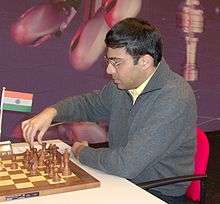Sport in India
| Part of a series on the |
| Culture of India |
|---|
 |
| History |
| People |
| Cuisine |
| Religion |
|
Music and performing arts |
| Sport |
|
India is home to a diverse population playing many different sports across the country. Cricket is the most popular sport. Football is a popular sport in some of the Indian states. The country has won eight Olympic gold medals in field hockey. Kabaddi, an indigenous sport is popular in rural India. Several games originated in India including chess, snooker and other regional games. India has won medals in badminton, kabaddi, hockey and many other sports and disciplines.
India has hosted and co-hosted several international sporting events, including the 2010 Commonwealth Games, the 1951 and 1982 Asian Games, the 1985, 1995 and 2016 South Asian Games, the 1987, 1996 and 2011 Cricket World Cup, the 2003 Afro-Asian Games, the 1989, 2013 and 2017 Asian Athletics Championships, the 1982 and 2010 Men's Field hockey World Cup, the 1979, 1987, 1991, 2003, 2010, 2013 and 2017 Asian Wrestling Championships, the 2009 BWF World Championships, the 2004, 2007 and 2016 Kabaddi World Cup (Standard style), the 1980,1992 and 2009 Asian Table Tennis Championships, the 1981 ABC Championship, the 2009 FIBA Asia Championship for Women, the 2005 and 2017 Asian Cycling Championships
The Indian Premier League (IPL) is a premier twenty20 cricket league held every year from 2008. The I-League and Indian Super League are football league tournaments held since 2007 and 2014 respectively, the Pro Wrestling League is a wrestling league held by Wrestling Federation of India since 2015, the International Premier Tennis League is a tennis league held jointly at India with other Asian countries and the Hockey India League is held since 2013.
Major international sporting events annually held in India include the Chennai Open in tennis, the Indian Masters in golf, the India Open since 2008 and Royal Indian Open since 2001 in badminton. From 2011 to 2013, India hosted the Indian Grand Prix Formula 1 race at the Buddh International Circuit, Greater Noida. The National Games of India is a national domestic sports event, which has been held in the country since 1924.
India will host the 2017 FIBA Women's Asia Cup, the 2017 FIFA U-17 World Cup, the 2017 ISSF World Cup, the 2016–17 Men's FIH Hockey World League and the 2018 Men's Hockey World Cup
Sports League to start in India are the Indian Athletics League and the Ultimate Table Tennis.
History
Before independence
The history of sports in India dates back to the Vedic era. Physical culture in ancient India was fuelled by religious rights. The mantra in the Atharvaveda, says, "Duty is in my right hand and the fruits of victory in my left." In terms of an ideal, these words hold the same sentiments as the traditional Olympic Oath: "For the Honour of my Country and the Glory of Sport.[1]" Badminton probably originated in India as a grownup's version of a very old children's game known in England as battledore and shuttlecock, the battledore being a paddle and the shuttlecock a small feathered cork, now usually called a "bird." Games like chess (chaturanga), snakes and ladders, playing cards, originated in India, and it was from here that these games were transmitted to foreign countries, where they were further modernised.
After independence
India hosted the Asian Games in New Delhi in 1951 and 1982. The Ministry of Youth Affairs and Sports was initially set up as the Department of Sports in 1982 at the time of organisation of the IX Asian Games in New Delhi. Its name was changed to the Department of Youth Affairs & Sports during celebration of the International Youth Year in 1985.[2] India has also hosted or co-hosted several international sporting events, including the 1951 and the 1982 Asian Games, the 1987 and 1996 Cricket World Cup, the 2003 Afro-Asian Games, the 2010 Hockey World Cup, and the 2010 Commonwealth Games. Major international sporting events annually held in India include the Chennai Open, Mumbai Marathon, Delhi Half Marathon, and the Indian Masters. The country co-hosted the 1987, 1996, 2011 Cricket World Cup and the first Indian Grand Prix in 2011.
Administration and funding
Political responsibility for sport in India is with the Ministry of Youth Affairs and Sports, which is headed by a cabinet minister and managed by National Sport Federations.[3] The only major exception is the BCCI which is the administrative body of Cricket, is not a NSF. Presently there are more than 70 recognised national sports federations (NSF), of which 38 have politicians at the helm.[4]
Sports Authority of India, the field arm of the Ministry, supports and nurtures talent in youth, and provides them with requisite infrastructure, equipment, coaching facilities and competition exposure.[5] Dorabji Tata, with the support of Dr. A.G. Noehren, then director of YMCA, established the Indian Olympic Association (IOA) in 1927. IOA is responsible for the Indian continent's participation in the Olympic Games, Commonwealth Games, Asian Games (outdoor, indoor and beach), and South Asian Games. Each Olympic and non-Olympic sport has a federation at the national level.[6]
The selection of the national teams is done by the respective national federations and then recommend to IOA for official sponsorship for participation in the games conducted under the auspices of the International Olympic Committee, Olympic Council of Asia, Commonwealth Games Federation, and SAG. A special feature of the Indian Olympic Association is that the National Federations and the State Olympic Associations are affiliated with and recognised by it. The main task of the State Olympic Associations is to promote the Olympic sport and to ensure co-ordination among the State Sports Associations. In 2010–11, the total budget for sports and physical education schemes is ₹31,177 million (US$490 million).[7] Hockey, in which India has an impressive record with eight Olympic gold medals, is said to be the national sport.[8] The Rajiv Gandhi Khel Ratna and the Arjuna Award are India's highest awards for achievement in sports, while the Dronacharya Award is awarded for excellence in coaching.
India has been criticised for neglecting women in sports, as depicted in the film "Chak De! India", where women's sports associations are under-sponsored and out of funds.
International sports events held in India
Following is a list of international sports events held in India:
India at major international sports events
Olympics
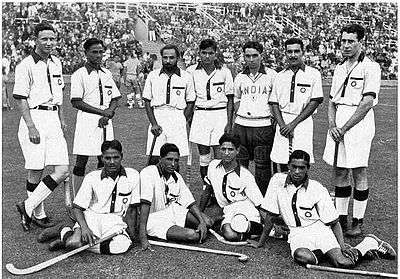
A single athlete, Norman Pritchard, represented India in the 1900 Olympics, winning two silver medals. India sent its first national team to the Olympics in 1920, and has participated in every Summer Olympic Games ever since. India has also competed at several Winter Olympic Games since 1964.
India has won a total of 26 Olympic medals. India won its first gold medal in men's field hockey in the 1928 Olympic Games. Abhinav Bindra became the first Indian to win an individual gold medal at the Olympic Games, and India's first gold medal since 1980, when the men's field hockey team won the gold.[9][10]
India has won very few Olympic medals, despite a population exceeding one billion, around half of them under the age of 25. Numerous explanations have been offered for the dearth, including poverty, malnutrition, widespread vegetarianism, neglected infrastructure, the lack of sponsorship, the theft of money and equipment, political corruption, institutional disorganisation, social immobility, the predominance of cricket, and other cultural factors.[11][12][13][14]
According to several informal statistics, India is the country with the lowest number of total Olympic medals per capita (out of those countries which have won at least one medal).[15][16] In the Winter Olympic Games, India has seen four consecutive representations–Nagano (Japan, 1998), Salt Lake City (Utah, USA, 2002), Turin (Italy, 2006), and Vancouver (British Columbia, Canada, 2010). Shiva Keshavan, Asian Champion in luge represented India in all four winter games.
Commonwealth Games
India has competed in fourteen of the eighteen previous Commonwealth Games; starting at the second Games in 1934 hosted the games one time. India hosted the Games in 2010, at Delhi. India is the fourth most successful country with a total of 436 medals including 156 gold medals.
Asian Games
India hosted the Asian Games in 1951 and 1982 at New Delhi. India is the sixth most successful country winning 602 medals including 139 gold. India has won the gold medal in Kabbadi ever since its inception.
The National Games of India
The National Games of India is a sporting event held in India. It comprises various disciplines in which sportsmen from the different states of India participate against each other. The country's first few Olympic Games, now christened as National Games
Olympic sports
Field Hockey
Field Hockey is a popular sport in India. Until the mid-1970s, India dominated international field hockey, winning eight Olympic gold medals and won the men's Hockey World Cup held in 1975. Since then, barring a gold medal in the 1980 Olympics, India's performance in field hockey has been dismal, with other hockey-playing nations such as Australia, Netherlands and Germany improving their standards and catching up with India. Its decline is also due to the change in rules of the game, introduction of artificial turf, and internal politics in Indian field hockey bodies. The popularity of field hockey has also declined massively parallel to the decline of the Indian hockey team. In recent years, the standard of Indian hockey has gone from bad to worse, with the Indian hockey team not qualifying for the 2008 Olympics and finishing last in the 2012 Olympics. Currently, the Indian team is 5th in the rankings of the Fédération Internationale de Hockey sur Gazon (FIH, English:International Hockey Federation), the international governing body of field hockey and indoor field hockey.[17]
India has hosted two Hockey World Cups–one in 1982 in Mumbai, and another in 2010 in Delhi, where they finished fifth and eighth respectively. India also hosted the annual Hockey Champions Trophy in 1996, 2005 and 2014. Until 2008, the Indian Hockey Federation (IHF) was the apex body for hockey in the country. However, following revelations of corruption and other scandals in the IHF, the federation was dissolved and de-recognised, and a new apex body for Indian hockey called Hockey India (HI) was formed on 20 May 2009, with support from the IOA and former hockey players. HI, recognised by the International Hockey Federation (FIH), has the sole mandate to govern and conduct all activities for both men's and women's field hockey in India. Although the IHF was reinstated in 2010,[18] it is not recognised by the FIH. The IHF conducts a franchise-based tournament called World Series Hockey (WSH), with its first season conducted in 2012. However, it is not approved by HI or the FIH.
HI also conducts a franchise-based tournament called the Hockey India League (HIL). Its first season was in 2013 and is inspired from the Board of Control for Cricket in India's (BCCI's) highly successful Indian Premier League. The tournament is recognised by the FIH, which has also decided to provide a 30-day window for the forthcoming seasons so that all top players can participate.
Cricket
Cricket has a long history in India, having been introduced in the country during the British rule. It is the most popular sport by a wide margin in India and is often considered to be an unofficial religion in India.[19] Cricket is played on local, national, and international levels, and enjoys consistent support from people in most parts of India. Its development has been closely tied in with the history of the country, mirroring many of the political and cultural developments around issues such as caste, gender, religion, and nationality. The Indian national cricket team played its first official match (a Test) in 1932 against England, and the team's performance since then has generally been mixed, sometimes enjoying stupendous success and sometimes suffering outright failure. The highest profile rival of the Indian cricket team is the Pakistani cricket team, though, in recent times, it has gained other rivals, including Australia, South Africa and England.
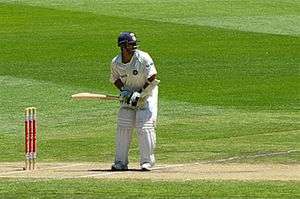
Although cricket is the most popular sport in India, it is not the nation's official national sport as India does not have a national sport.[20] The governing body for cricket in India, the Board of Control for Cricket in India (BCCI), was formed in December 1928 and is based in Mumbai. Today, BCCI is the richest sporting body in the world.[21]
India has hosted or co-hosted a large number of multi-nation major international cricket tournaments, including the 1987 Cricket World Cup (co-hosted with Pakistan), the 1996 Cricket World Cup (co-hosted with Pakistan and Sri Lanka), the 2006 ICC Champions Trophy and the 2011 Cricket World Cup (co-hosted with Sri Lanka and Bangladesh). The India national cricket team has won major tournaments, including the 1983 Cricket World Cup in England, the 2007 ICC World Twenty20 in South Africa, the 2011 Cricket World Cup (which they won by beating Sri Lanka in the final at home), and the 2013 ICC Champions Trophy, and has shared the 2002 ICC Champions Trophy with Sri Lanka. It had also briefly held the position of the No. 1 team in Tests.[22] The domestic competitions include the Ranji Trophy, the Duleep Trophy, the Deodhar Trophy, the Irani Trophy, and the Challenger Series, all of which are not widely followed, despite cricket's popularity in the country. This parallels the global situation in cricket, where the international game is more widely followed than the domestic game in all major cricketing countries. In addition, the BCCI conducts the Indian Premier League, a domestic franchise-based Twenty20 competition, during March–April every year and is extremely popular.
Football
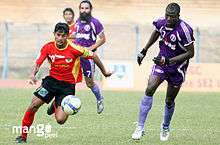
Football was introduced to India during the British colonial period. Although India has never been represented in any FIFA World Cup, it did qualify in 1950, though it did not take part, as they were not allowed to play barefoot.[23] India was an Asian powerhouse in football in the 1950s and 1960s. During this golden era, India created history as the first Asian team to reach semi-finals in an Olympic football tournament in 1956 Summer Olympics at Melbourne and Neville D'Souza became the first Asian and Indian to score a hat-trick (record remains unbeaten) in an Olympic match.[24][25] India also finished as runners-up in the 1964 AFC Asian Cup. But later on, the standard of football started to decline due to lack of professionalism and fitness culture. India currently ranks 100th in the FIFA rankings as of 10 May 2017.[26]
Football is, nevertheless, widely popular both as a spectator sport, and as a participation sport in some parts of the country such as Kerala, West Bengal, Goa and the Northeast. The India national football team represents India in all FIFA tournaments. The Yuva Bharati Krirangan of Kolkata was the second largest non-auto racing stadium in the world.
In June 1937, at the Army Headquarters, Shimla, the All India Football Federation (AIFF) was formed at a meeting of the representatives of football associations of six regions where the game was very popular in those days. It is the governing body for football in India. Domestic competitions for men's football include the Indian Super League, I-League, I-League 2nd Division in the Indian League System and the annual knock-out style Federation Cup. For women's football the India women's football championship. However, it is European football, such as the English Premier League, Spanish La Liga, and the UEFA Champions League, which are very popular among Indian football fans, especially in metropolitan cities.
The 2017 FIFA U-17 World Cup will be the 17th tournament of the FIFA U-17 World Cup. FIFA revealed on 5 December 2013 (as part of their Executive Committee meets in Salvador, Brazil), that India will be the host. This will be the first time India will host an international football competition at world level.[27]
Tennis
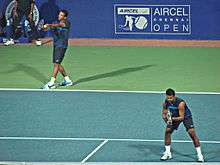
Tennis is a sport among Indians in urban areas. Tennis has gained popularity after the exploits of Vijay Amritraj. India's fortunes in Grand Slam singles have been unimpressive, although Leander Paes won a singles bronze medal at the 1996 Olympics. Since the late 1990s India has had impressive results in Grand Slam doubles, Leander Paes and Mahesh Bhupathi have won many men's doubles and mixed doubles Grand Slam titles. Sania Mirza is the most notable Indian woman tennis player, having won a WTA title and breaking into the Top 30 WTA rankings, also winning three Grand Slam doubles events, the first at Wimbledon in 2015. On the men's side, young Somdev Devvarman and Yuki Bhambri are flying India's flag on the ATP Tour. Yuki was the Australian Open junior singles champion in 2009. Rohan Bopanna has won two mixed doubles titles.
Badminton
.jpg)
Badminton is played widely in India and it is one of the most popular sports in India. Badminton's popularity has grown in these years. Indian shuttler Saina Nehwal has been ranked in the top-10 rankings since 2010, peaking at no. 1 in 2015.,[28] and has been named the Most Promising Player of 2008 by the Badminton World Federation. The most successful doubles player from India is Jwala Gutta, who is the only Indian to have been ranked in the top-10 of two categories. She peaked at no. 6 with Valiyaveetil Diju in mixed doubles and at no. 10 with Ashwini Ponnappa in women's doubles.[29] Other successful players include P.V. Sindhu, Aparna Popat, Prakash Padukone, Pullela Gopichand, Syed Modi, Chetan Anand, Parupalli Kashyap, Prannoy Kumar and K. Srikanth.
Padukone and Gopichand, both won the All England Open in 1980 and 2001 respectively making them the only Indians to ever win the prestigious title. At the 2012 London Olympic Games, Nehwal won the bronze medal in the individual women's competition, the first for the country. India has won medals at the BWF World Championships as well, with Padukone winning in 1982. The doubles pairing of Gutta and Ponnappa became the first women to win the medal when they won the bronze in 2011.[30] Sindhu won consecutive medals at 2013 and 2014 editions. Nehwal won a silver at 2015 Championships. Badminton is a fast growing sport in India.[31]
Basketball
Basketball is a popular sport in India, played in almost every school, although very few people follow it professionally. India has both men's and women's national basketball teams. Both teams have hired head coaches who have worked extensively with NBA players and now aim to popularise the game in India.[32] Satnam Singh Bhamara officially marks the first player from India to be selected in the NBA by being taken by the Dallas Mavericks as the 52nd pick of the 2015 NBA draft, as well as the first player to be drafted straight out of high school as a postgraduate.
The Young Cagers, as the national team is nicknamed, made one Olympic appearance in basketball, and appeared 20 times in the Asian Championship. India is currently ranked 58th in the world in basketball. The Indian national team had its best result at the 1975 Asian Championship, when the team finished ahead of teams including the Philippines, one of Asia's basketball strongholds. Internationally, one of the most recognised Indian basketball players has been Sozhasingarayer Robinson.[33] Affiliated into the International Basketball Federation (FIBA) since 1936, India has one of Asia's longest basketball traditions.[34]
India's women had their best result at the recent 2011 FIBA Asia Championship for Women when they finished 6th. The team has several internationally known players including Geethu Anna Jose, who was invited to tryouts for the WNBA in 2011.[35]
Table tennis
Table tennis is a popular indoor recreation sport in India, which has caught on in states including West Bengal and Tamil Nadu. The Table Tennis Federation of India is the official governing body of the sport. India, which is ranked 30th in the world, has produced a single player ranked in the top 50, Sharat Kamal.[36]
Golf
Golf is a growing sport in India. It is especially popular among the wealthier classes, but has not yet caught on with others due the expenses involved in playing.
The most successful Indian golfers are Jeev Milkha Singh and Anirban Lahiri. Singh won three titles on the European Tour, four on the Japan Golf Tour, and six on the Asian Tour. His highest world ranking was 28th in March 2009. Singh has won the Asian Tour Order of Merit twice. Meanwhile, Lahiri has two European Tour wins and seven Asian Tour wins. He qualified for the 2015 Presidents Cup.
Other Indians who have won the Asian Tour Order of Merit are Jyoti Randhawa in 2002 (the first Indian to do so), and Arjun Atwal, who went on in 2010 to become the first India-born player to become a member of the US-based PGA Tour and win the 2010 Wyndham Championship.
In golf at the Asian Games, India's men's golf team won gold at the 1982 Asian Games, and silver at the 2006 Asian Games. Lakshman Singh won the individual gold at the 1982 Asian Games.
There are numerous golf courses all over India, and a Professional Golf Tour of India. The main tournament is the Hero Indian Open, co-sanctioned by the Asian Tour and European Tour.
Boxing
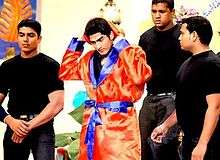
Boxing is a highly profiled sport in India, and although it is a regular medal-holder at the Asian Games and Commonwealth Games, though India has not yet produced a world champion in any weight class. In November 2007, India's Mary Kom won the best boxer title and secured a hat-trick of titles. During the 2008 Beijing Olympics, Vijender Singh won a bronze medal in the middleweight division, and Akhil Kumar and Jitender Kumar qualified for the quarterfinals. Akhil Kumar, Jitender Kumar, A.L. Lakra, and Dinesh Kumar each won a bronze medal at the 2008 World Championship. India's lone women boxer, M.C. Mary Kom, won the bronze medal at the 2012 London Olympic Games.
Wrestling
Considered one of the most ancient and oldest sports in the world, wrestling in India has a glorious past. The sport of wrestling began its journey in India several centuries ago, during the Middle Ages. Wrestling is among the most prestigious and oldest events in the Olympic Games. It was included in the Olympics in 708 BC. In ancient times, wrestling in India was mainly used as a way to stay physically fit. It was also used as a military exercise without any weapons. Wrestling in India is also known as dangal, and it is the basic form of a wrestling tournament.
In India, wrestling is mostly known as Malla-Yuddha. There are mentions of wrestling in the ancient times, found in the Sanskrit epic of Indian history, Mahabharata. One of the premier characters in Mahabharata, Bhima, was considered to be a great wrestler. Other great wrestlers included Jarasandha, Duryodhana, and Karna. Another Indian epic, Ramayana, also mentions wrestling in India, describing Hanuman as one of the greatest wrestlers of that time. The 13th-century Malla Purana references a group of Gujarati Brahmin wrestlers known as Jyesthimallas.
Weightlifting and powerlifting
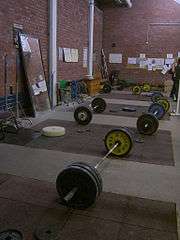
Karnam Malleswari won a bronze medal at the 2000 Summer Olympics in Sydney, making her the first Indian woman to win an Olympic medal.[37] The headquarters of the Indian Weightlifting Federation is in New Delhi. The federation is affiliated with the Indian Olympic Association (Delhi), and is also a member of the Asian Weightlifting Federation (Tehran) and International Weightlifting Federation (IWF, Budapest). The International Weightlifting Federation banned the Indian Weightlifting Federation from participating in all international competitions for one year when three Indian women weightlifters were accused of doping offences in various international competitions in a single year.
Archery
The game of archery has historical significance, as royals in the ancient days used to practice archery. Modern-day archery in India began in the early 1970s, before its introduction as an Olympic event in 1972, and it was formalised in 1973 when the Archery Association of India (AAI) came into existence. Since its inception, AAI has been promoting an organisation for the sport. India has been producing some world class players who are the medal hopefuls in international events of archery.
Volleyball
Volleyball is a popular recreation sport played all over India, both in rural and urban areas. India is ranked fifth in Asia, and 27th in the world. In the youth and junior levels, India came in second in the 2003 World Youth Championships. The Indian senior men's team is ranked 46th in the world. A major problem for the sport is the lack of sponsors.[38]
Handball
Handball is a popular sport in India, played at the local level, but hasn't yet made an impact at the domestic level. India's handball team began on 27 April 1989, although it hasn't yet made an impact on the world stage, at the international level or the World Cup.Handball is the one of the most fastest game.our chennai government handball team scored 30 goals in first half.It is the most fitness game.The Handball Federation of India manages handball in India.[39]
Taekwondo
Taekwondo in India is administered by the Taekwondo Federation of India which was founded by Jimmy R. Jagtiani.[40] Surendra Bhandari won a bronze medal in taekwondo at the 2002 Asian Games. Taekwondo is widely practised in India, with actors Neetu Chandra, Akshay Kumar and Isha Koppikar holding black belts.
Rugby
Rugby union is a minor, but fast-growing, sport in India. Some Indian sporting clubs are beginning to embrace the game, and it is the second most popular winter sport after football in India, which itself trails in popularity after cricket and field hockey.
Cycling
The history of cycling in India dates back to 1938, and the Cycling Federation of India governs the sport. Though cycling is unknown as a professional sport in India, it is popular as a common recreational sport and a way to keep fit.
- Mountain biking
Mountain biking is becoming a popular sport in India. For the last six years, Mtb himachal, a hardcore endurance event, has been organised regularly by Himalayan Adventure Sports & Tourism Promotion Association (HASTPA), a non-governmental organisation (NGO). A number of national and international riders participate, including Indian Army, Indian Air Force, Indo-Tibetan Border Police (ITBP), and a number of young and energetic mountain biking individual riders from cities including Pune, Bangalore, Delhi and Chandigarh. Last year, the government of Sikkim (Department of Tourism) introduced its own mountain biking race, with Southeast Asia's biggest prize money. The second edition saw 48 professional participants from around the globe.
- Road Cycling/ Touring
The Tour of Nilgiris is a major non-competitive & non-commercial touring event in South Asia that covers 1,000 kilometres in under 10 days.[41] The Tour of Nilgiris (TfN), India's first Day Touring Cycle Ride, was born in December 2008 with the twin objectives of promoting bicycling as an activity and spreading awareness about the bio-diversity, flora and fauna of the Nilgiris.
It soon grew into something a lot more, with an eclectic riding community in 2008 wanting to take part in. The community soon got together, chalked out plans, figured out a route and realised they would need a framework to support such a large group of people, got sponsors on board to mitigate costs as well as popularise the Tour and the Cause of popularising Cycling as a viable and sustainable means of travel. Ever since its first edition, the TfN has stayed true to the Community of Cyclists in India by being a Tour for the Community, Of the Community and By the Community. It has grown in size, stature and visibility. From 40 riders in the first edition, its grown to 100 cyclists in 2013.
The tour has grown bigger & the routes tougher, allowing cyclists to test their endurance, enjoy the biodiversity of the Nilgiris covering 3 southern states in India (Karnataka, Tamil Nadu & Kerala). For the racing aficionado's, there are racing segments on the tour with colour coded jerseys, recognition and prizes. TfN as its lovingly called is pushing cycling to new frontiers with more and more interested cyclists, applying for the tour. The tour has acquired quite a name, and currently about 25% of registrations are selected for the tour by the organisers.
Equestrian sports
India has a wide following in various equestrian sports, including show jumping, eventing, dressage, endurance riding and tent pegging. Supported by the Equestrian Federation of India, eventing is the most popular of the five, with teams representing the country at most Asian Games, winning a bronze medal in the 2002 and 2006 games. India has been represented at the Olympics twice, by Wing Commander I.J. Lamba, and Imtiaz Anees.
Kayaking
- Flat water and sea kayaking
Indian flat water kayakers are an emerging powerhouse on the Asian circuit. Outside of professional flat water kayaking, there is very limited recreational kayaking. The potential to generate interest in flat water kayaking is held by leisure resorts located near the sea or other water bodies. Indian tourists tend to consider kayaking a one-time activity, rather than a sport to be pursued.
- Whitewater kayaking
Enthusiasts of whitewater kayaking are concentrated in the north towards the Himalayas, with some in the south in Bangalore in Karnataka. Most of these enthusiasts are or were whitewater raft guides who took to the sport of whitewater kayaking. Some of the prominent whitewater kayakers include Abhinav Kala, Shalabh Gahlaut, and John Pollard. Many of them have notched first descents (similar to climbing ascents) on rivers in India and Nepal.
"Bangalore Kayakers" or "Southern River Runners" are India's first amateur group of white water kayakers. Based out of Bangalore, they explore rivers around Western Ghats.[42] The lure for most of these participants is adventure. Whitewater kayaking in India allows for exploration of places where, literally, no human has been before.
Gear availability is a problem that plagues kayakers. While the global designs for whitewater boats and paddles change annually, Indian kayakers have to pay high fees if they want to import any kind of gear, or they have to buy used gear in Nepal. More often than not, one will see Indian kayaking guides riding down the river in a Perception Amp, Piroutte or Dancer designs, while the kayakers from abroad ride the river in their new design, planing hull, centred volume kayaks from Riot, Pyranha, or Wave Sport.
Kayaking India groups on Facebook are good resources for kayakers in India.
Athletics and triathlon
Madhurjya Borah, an Indian triathlete holds silver medal at South Asian Triathlon Championship
Anu Vaidyanathan, an Indian triathlete, is the first Asian to compete in Ultraman.[43]
In May 2016, Arunaabh Shah from Delhi became the 1st Indian male and the youngest Indian to finish Ultraman, at Ultraman Australia.[44]
Gymnastics
Gymnastics came of age in India when, at the 2010 Commonwealth Games, Ashish Kumar won the first-ever medal in gymnastics for India and also won a bronze medal.[45] However, soon after the win, the president of the Gymnastics Federation of India, controversially asked Kumar's chief coach from the Soviet Union, Vladimir Chertkov, "Is this all that you can deliver, a bronze?" The comment was widely reported in the press. Later, the coach revealed that, "In August 2009, we had no equipment. Ashish trained on hard floor till February 2010, and then we got equipment around 20 years old." The federation announced that no Indian team would travel to Rotterdam for the World Championships in October, which would mean that Indian gymnasts would not have the opportunity to qualify as a team for the 2012 Summer Olympics.[46][47]
Non-olympic sports
Billiards and snooker
India has been a force in world billiards competitions. Champions including Wilson Jones, Michael Ferreira, Geet Sethi and now the domination of Pankaj Advani have underlined the powerhouse status of the country. The Snooker Federation of India, the apex body, plays a proactive role in popularising the game. Many efforts have been made by the Billiards and Snooker Federation of India in the recent past to enhance the popularity of the game in the country. Several training camps for developing budding talent and providing them with regional and state sponsorship have been organised by the Billiards and Snooker Federation in various parts of the country.
Chess
Chess has risen in popularity in India over the last few decades, primarily due to its star player Viswanathan Anand. He is a multiple World Champion. The game may have originated from India as a successor to Chaturanga or Shatranj. The All India Chess Federation is the governing body for chess in India.
Kabaddi

Kabaddi is a popular national sport in India, played mainly among people in villages. It is regarded as a team-contact sport and as a recreational form of combat training.
Two teams occupy opposite halves of a small field and take turns sending a raider into the other half to win points by tagging and wrestling members of the opposing team. The raider then attempts to return to his own half while holding his breath and chanting "kabaddi, kabaddi, kabaddi" during the whole raid.
India has won gold in all the Asian Games in kabaddi. The four forms of kabaddi recognised by Kabaddi federation in India are Amar, Sanjeevni, Gaminee and Punjabi rules Kabaddi. India won the Kabaddi World Championship in 2007, beating Iran 29–19.[48]
Motorsports
Motorsport is a popular spectator sport in India, although there are relatively few competitors compared to other sports, due to the high costs of competing. Coimbatore is often referred to as the "Motor sports Capital of India" and the "Backyard of Indian Motorsports".[49] S.Karivardhan, spearheaded motor racing, making Coimbatore the country's motor racing hub when he designed and built entry level race cars. Before Buddh International Circuit was constructed, the country's only two permanent race ways were the Kari Motor Speedway, Coimbatore and Madras Motor Racing Track, Chennai.[50] MRF built the first Formula 3 car in 1997.[51] MRF in collaboration with Maruti established the Formula Maruti racing, a single-seater, open wheel class motorsport racing event for race cars made in India.[52] MRF Challenge is a Formula 2000 open-wheel motorsport formula based series organised by Madras Motor Sports Club in association with MRF. Narain Karthikeyan and Karun Chandhok are the only drivers from to represent India in Formula 1.

On 1 February 2005, Narain Karthikeyan became India's first Formula One racing driver. On March 2007, he also became the first-ever Indian-born driver to compete in a NASCAR Series. He debuted in the NASCAR Camping World Truck Series in the Kroger 250.[53] Force India F1 is a Formula One motor racing team. The team was formed in October 2007, when a consortium led by Indian businessmen Vijay Mallya and Michiel Mol bought the Spyker F1 team for €88 million.[54] After competing in 29 races without a point, Force India won their first Formula One World Championship points and podium place when Giancarlo Fisichella finished second in the 2009 Belgian Grand Prix.[55] New Delhi hosted the Indian Grand Prix in 2011 at Buddh International Circuit in Greater Noida, 50 km from New Delhi. Karun Chandhok was the test driver for Team Lotus & Narain Karthikeyan raced for HRT during the first half of the 2011 Formula One season. Karun Chandhok participated in Friday's practice session and Karthikeyan (stepping in for Daniel Ricciardo) raced at the 2011 Indian Grand Prix; it was the first time two Indian drivers associated with the same Formula One Grand Prix directly.
Team MRF's Gaurav Gill the first Indian rally driver to win FIA Asia-Pacific Rally Championship in 2013.[56][57]
Korfball

Korfball, a mixed-gender ball sport, with similarities to netball and basketball, is played by over 50 countries in the world. It is not as popular in India as other sports, but is still played by a significant amount of people. India came in third place twice (2002 & 2006)[58] in the Asia-Oceania Korfball Championships.
Karate
Karate in India is administered by the All India Karate Federation[59] whose president is [[Karate RAMESHVAR NIRVAR AIKF. India has produced many accomplished karatekas like Syeda Falak and Sabari Karthik. The 2011 Asian Sports Karate Games were held in Tamil Nadu, India.
Floorball
Floorball, an indoor team sport, a type of floor hockey, is gaining popularity in India. The Floorball Federation of India was started in 2001 and, since then, it has expanded rapidly. There have been four national floorball championships held, with Uttar Pradesh becoming the champions. Women's floorball has also expanded, and Mumbai is the first national floorball champion of India. India is a provisional member of the International Floorball Federation. India has participated in many international friendlies and steps are being taken to make India an ordinary member of floorball.[60]
Netball
Netball, derived from early versions of basketball, is a popular sport in India, especially among Indian women. India's national team is ranked 25th in the world and has played only a few matches. The team has failed to qualify for any of the World Netball Championships. They played 18 matches in total.[61] In the 2010 Commonwealth Games in Delhi, India, netball was included as a medal sport. However, the Indian team failed to win a medal.
Throwball
Throwball, a non-contact competitive ball sport played across a net between two teams of seven players on a rectangular court, is gaining popularity in India. Indian authorities of the game were instrumental in organising an Asian level and, later, a world level association for the sport. Throwball is played in gym class, colleges, and clubs throughout Asian countries such as India, Sri Lanka, Korea, Thailand, Malaysia, Japan, China, Pakistan, Nepal, Bhutan, and Bangladesh. The sport is also slowly gaining in popularity in other countries including France, Australia, Brazil, Canada, and the United Kingdom. India's junior throwball team visited Sri Lanka in 1982. Vijay Dahiya from Haryana was captain of the team. The Indian team won the test series.
Lacrosse
Lacrosse is a relatively new sport in India, introduced in 2006. The governing body for lacrosse in India is the Indian National Lacrosse Federation. It is now being played by schools in Shillong, Meghalaya, while being mostly unknown in the rest of the country.
American football
Introduced in 2011 by various American football figures, including Mike Ditka and Ron Jaworski, the Elite Football League of India was India's first professional American football league. Their first league play was to commence in 2012, and feature teams from eight different Indian cities, including Mumbai, Kolkata, Delhi, and Jaipur.[62]
Polo
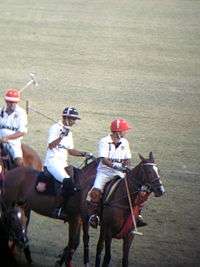
India is considered the cradle of modern polo. Babur, the founder of the Mughal Empire in the 15th century, firmly established its popularity. The period between the decline of the Mughal dynasty and the upsurgence of the British Imperial rule, polo almost vanished from mainland India. Fortunately, the game survived in a few remote mountainous enclaves of the subcontinent, notably Gilgit, Chitral, Ladakh, and Manipur.
In India, the popularity of polo has waned and risen many times. However, it has never lost its regal status. In the last few decades, the emergence of privately owned teams has ensured a renaissance in Indian polo. Today, polo is not just restricted to the royalty and the Indian Army.
Baseball and softball
Baseball has recently begun to show up in India. Softball is played in school and at the university level. Two Indian pitchers were selected by the "Million Dollar Arm" competition to play in the United States. A talent hunt-style competition conducted by Major League Baseball to find baseball talent in India found the teenagers Rinku Singh and Dinesh Patel, who were taken to the US and received professional coaching.[63] These two players were selected to play for Pittsburgh Pirates minor league organisations. Rinku Singh played for the Canberra Cavalry of the Australian Baseball League for the competition's inaugural 2010–11 season.
Rock climbing
Rock climbing has been around in India for a long time. Presumably, the mountaineers headed for Himalayan ascents had to train somewhere, and would have imparted some of the initial technical climbing culture. Documented evidence of rock climbing is associated with bouldering and climbing around Bangalore's famous Ramanagara crags and Turahalli boulders, around Western Ghats closer to Mumbai and Pune. The Deccan Plateau and south of the Vindhya Range are considered the prime locations for rock climbing in India. There is an established climbing tradition associated with Mumbai, Pune, and Bangalore. For example, Hampi is considered the bouldering capital of India. Climbers congregate here during New Year's Eve and climb through the weeks preceding and after. Badami is popular for its free and sport routes (numbering over 200).
Sepak takraw

Sepak takraw, though not very well known in India, was a demonstration sport at the Delhi Asian Games in 1982.[64] The Sepak Takraw Federation, with its headquarters in Nagpur, Maharashtra, was founded on 10 September 1982. It is recognised by the Indian Olympic Association and Ministry of Youth Affairs and Sports since 2000.[65] So far, the federation has conducted 14 senior, seven junior, and six sub-junior national championships in different cities, and is conducting Federation Cup Tournaments and zonal National Championships.
The game is very popular in the northeastern state of Manipur, and some of the best players came from there. In the 22nd King's Cup International Sepak Takraw Tournament held in Bangkok, the India men's team lost in the semi-finals and claimed bronze in the team event. In the doubles event, the women's team lost in the semi-finals, but earned bronze medals.[66]
Winter sports
Winter sports are common in India in the Himalayan areas. Skiing tournaments take place every winter in Gulmarg, Kashmir, and Manali. Winter sports are generally more common in the northern states of Jammu and Kashmir, Himachal Pradesh, Uttaranchal, Sikkim, and Arunachal Pradesh. Skiing, snow rugby, snow cycling, and snow football are some of the common winter sports played in India. Skiing is more popular, although India has taken part in luge in Winter Olympics since 1998. Shiva Keshavan is the only Indian to have won medals in international meets in winter sports (Asian Gold 2011, Asian Silver 2009, Asian Bronze 2008, Asian Silver (doubles) 2005, Asian Bronze (singles) 2005), and to have participated in four Olympic Games. He is the Asian speed record holder at 134.4 km/h, making him the fastest man in Asia on ice. Luge is practised in a big way by the mountain residents in an improvised form called "reri".
Bandy
India has a national bandy team. The Bandy Federation of India governs bandy in India. Its headquarters are in Mandi in Himachal Pradesh. Bandy, a team winter sport played on ice, in which skaters use sticks to direct a ball into the opposing team's goal, is generally played in northern India, where there is snow and ice. India is one of seven countries in Asia and out of a total of 28 to be a member of Federation of International Bandy. BFI planned to send a team to the 2011 Asian Winter Games in Astana-Almaty,[67] but ultimately did not.[68]
Ice hockey
Ice hockey is played in the colder parts of India, including Kashmir, Ladakh, and parts of Himachal Pradesh.[69]
Traditional and regional sports
Seval Sandai
Seval Sandai or Seval Porr (cockfighting) is a popular rural sport. Three or four-inch blades are attached to the cocks' feet and the winner is decided after three or four rounds of no holds barred fighting. The sport involves major gambling in recent times.
Jalikattu

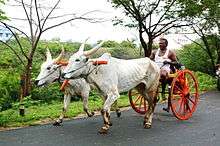
Jallikattu is a popular bull taming sport practiced particularly during Pongal festival. Jallikattu was a popular sport since the Tamil classical period.[70][71] Rekla race is an associated sport which is a form of bullock cart racing.[72] In May 2014, the Supreme Court of India banned both the sports citing animal welfare issues.[73]
Gilli-danda
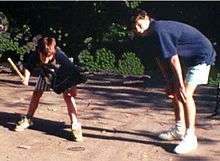
Gilli-danda is a sport played by using one small stick (gilli) and a large stick (danda) like cricket, with the ball replaced by gilli. It is still played in villages of Karnataka, Tamil Nadu, Rajasthan, Uttar Pradesh, Madhya Pradesh, Bihar, Maharashtra and Gujarat in India only as a recreational sport among boys.
Kancha
Kancha is played by using marbles. Marbles are glass balls which are very popular among children. It is popular in small Indian cities and villages, among small boys only as a gully sport. It is rarely played by girls. The participant has to hit the marble kept in a circle. If he hits the target properly, he wins. The winner gets the kancha of the other participant boys.[74]
Kite-flying
Kite-flying is pursued by many people in India, in cities as well as villages. The festival of Makar Sankranti features kite-flying competitions.It is festival which is a passion among Indians .
Indian martial arts
India has many traditional regional forms of martial arts like lathi khela, sqay, kalari, kusti, thang-ta and silambam.
Kho-kho
Kho kho is a tag sport played by teams of twelve players who try to avoid being touched by members of the opposing team, only 9 players of the team enter the field.[75] It is one of the two most popular traditional tag games played in schools, the other being kabbadi.[76]
Others
Uriyadi involves smashing a small earthen pot with a long stick usually with a cloth wrapped around the eyes to prevent the participants from seeing the pot.[77] Other minor sports include Ilavatta kal where lift huge spherical rocks,[78] Gilli-danda played with two pieces of sticks, Nondi played by folding one leg and hopping squares. Some of the indoor games include Pallanguzhi involving beads, Bambaram involving spinning of top, Dhayakattai which is a modified dice game, Aadu puli attam, Nungu vandi and Seechangal.[79] Other regional sports and games, including air sports, atya patya, langdi, surr, sitolia bridge, carrom, cycle polo, fencing, judo, Gatka, kho-kho, mallakhamb, roller skating, rowing, shooting ball, soft tennis, squash, swimming, ten-pin bowling, tennikoit, tug of war, yachting, and yoga, have dedicated followers and their own national sports federations.[80] There are other seasonal sports like "Dahi Handi" which have a great public following as well.
Sports Broadcasting in India
Local sporting events broadcasting is in a stagnant stage in India due to the mandatory sharing of sporting events of live feed and rights made by ordnance in favour of Prasar Bharathi. Thus, all sports broadcasters playout from outside the country, which only allows the capability to produce international events and fades the production, distribution, invention of the new local field of sporting events.
Sports Leagues in India
National
Green background for the major IPL-Style sports leagues. Blue background for the major sports leagues.
The no of season are as on August 2016.
International
| League | Current Sponsored | Game | Participation | Seasons | Teams | Indian Teams |
|---|---|---|---|---|---|---|
| AFC Cup | |
Club Teams | 13 | 32 | 2 | |
| International Premier Tennis League (IPTL) | Coca-Cola | |
Club Teams | 2 | 4 | 1 |
Youth Sports Leagues
- I-League U19 (association football)
Others
- Ring Ka King (Professional Wrestling)
- Super Fight League (Mixed Martial Arts)
Proposed League
| League | Current Sponsored | Game | Participation | Seasons | Teams |
|---|---|---|---|---|---|
| Indian Athletics League | |
Club Teams | |||
| Indian Series of Boxing[81] | |
Club Teams | TBA | ||
| i1 Super Series | |
Club Teams | 9 (Proposed) |
Leagues that are defunct
| League | Game | Participation | Seasons | Teams |
|---|---|---|---|---|
| Indian Cricket League (ICL) | |
Club Teams | 2 | 9 |
| ICL World Series (ICL World Series) | |
Club Teams | 2 | 4 |
| National Football League | |
Club Teams | 11 | 10 |
| Premier Hockey League (PHL) | |
Club Teams | 4 | 7 |
See also
References
- ↑ Sharma Sushant, https://www.sportskeeda.com/cricket/sports-fanaticism-in-india-history-and-where-are-we-today
- ↑ "Department of Sports". YAS. Retrieved 1 August 2010.
- ↑ "S". Yas.nic.in. Retrieved 1 August 2010.
- ↑ http://www.cppr.in/article/government-is-a-spoilsport/
- ↑ "Sports Authority of India, Ministry of Youth Affairs and Sports – Government of India". Sportsauthorityofindia.nic.in. Retrieved 1 August 2010.
- ↑ "Indian Olympic Association". Olympic.ind.in. Retrieved 1 August 2010.
- ↑ http://yas.nic.in/writereaddata/linkimages/6831719428.pdf
- ↑ "1.Dr. RAMAKRISHNAN .K.S. 2 VIDYALAXMI V 3 Dr. SARATHBABU.V. "DEVELOPMENT SPORTS PROFESSION AS A LIFE TIME PROFESSIONAL CAREER IN SPORTS – A PROSPECTIVE STUDY." Shodh Sangam 2.special (2012): 248-255–Uttar Pradesh, India". http://shodhsangam.org/article/january-2012-special-issue-volume-2/8.html. Retrieved 13 May 2015. External link in
|publisher=(help) - ↑ Medalists – India, The official website of the Beijing 2008 Olympic Games
- ↑ New York Times: With India’s First Gold, Suddenly a Billion People Notice the Olympics
- ↑ mystery of the missing medals
- ↑ Track and failed: the making of a sleeping Olympic giant
- ↑ Olympic machismo: The tale the medals tell
- ↑ "Olympic Medals/Population". Photius Coutsoukis. Retrieved 20 August 2008.
- ↑ "Per Capita Olympic Medal Table". Herman de Wael. Retrieved 20 August 2008.
- ↑ "Champions Trophy – India". Hockey Australia. Retrieved 1 March 2013.
- ↑ "KPS Gill and IHF reinstated by Delhi High Court". Breakingnewsonline.net. 22 May 2010. Retrieved 1 March 2013.
- ↑ "Fisher & Paykel uses cricketa to appeal to new Indian market – Current: Electrical, Electronics and Appliance Industry News and Issues". Current. 23 May 2010. Retrieved 1 March 2013.
- ↑ Press Trust of India (2 August 2012). "Hockey is not India's national game: Sports Ministry | Other Sports - Hockey | NDTVSports.com". Sports.ndtv.com. Retrieved 2013-10-21.
- ↑ "BCCI – The Richest Sporting Concern in the World". RichPeopleThings. Retrieved 1 March 2013.
- ↑ "India: No. 1 Test team – News Stories, Latest News Headlines on Times of India". The Times of India. 6 December 2009. Retrieved 1 March 2013.
- ↑ Chaudhuri, Arunava. "The Indian National Team's World Cup qualifying". Indianfootball.de. Retrieved 1 March 2013.
- ↑ "Football: India's day of Glory at Melbourne".
- ↑ Nitin N. Sethi (13 January 2004). "Mumbai salutes soccer legend". The Indian Times. Retrieved 8 March 2009.
- ↑ "India: FIFA/Coca-Cola World Ranking - FIFA.com".
- ↑ 2017 FIFA U-17 World Cup
- ↑ "BWF – BWF World Ranking – Overview". bwfcontent.tournamentsoftware.com. Retrieved 1 August 2010.
- ↑ "Jwala Gutta". Tournamnent Software. Retrieved 24 March 2016.
- ↑ http://www.ibnlive.com/news/india/jwala-gutta-ashwini-ponnappa-ousted-from-world-championships-710154.html
- ↑ "Saina Nehwal". london2012.com. Retrieved 2 September 2012.
- ↑ The Times of India – Sports – I'm here to create a superstar, says India's NBA coach Kenny Natt, timesofindia.com, written 14 June 2011, accessed 21 October 2011.
- ↑ Mumbai Mirror – To hell and back for cager Robinson, Mumbaimirror.com, written 4 March 2009, accessed 15 October 2011.
- ↑ FIBA.com – National Federations & Leagues
- ↑ ESPN.com – Geethu Anna Jose gets 3 tryouts
- ↑ "Team Ranking". ittf.com. Retrieved 5 October 2010.
- ↑ Time (27 December 2000). "'I Did What I Could for My Country'".
- ↑ Fédération Internationale de Volleyball (FIVB). "FIVB World Rankings". Retrieved 19 September 2009.
- ↑ "Handball India". Sports in India. handballindia.com. Retrieved 5 August 2011.
- ↑ http://timesofindia.indiatimes.com/india/Fatherland-of-Taekwondo-ready-to-invest-in-Indian-talent/articleshow/122161
- ↑ admin, on 30 May 2010. "The Tour of Nilgiris". The Tour of Nilgiris. Retrieved 1 August 2010.
- ↑ "Niet compatibele browser". Facebook. Retrieved 1 August 2010.
- ↑ Sharma, Deepika (5 September 2009). "India's new Iron lady". Hindustan Times.
- ↑ Journal, Yogesh Kumar/The Outdoor. "Arunaabh Shah – India's youngest Ultraman". Retrieved 2016-11-24.
- ↑ "I could have got gold had equipment arrived earlier: CWG medallist Ashish". Hindustan Times. 9 October 2010.
- ↑ Swamy, V Narayan (9 October 2010). "Officials ask Ashish's coach: Only a bronze?". The Times of India.
- ↑ "No Worlds for India: Coach Blasts Federation". International Gymnast Magazine. 10 October 2010.
- ↑ "Welcome to International Kabaddi Federation". Kabaddiikf.com. Retrieved 1 August 2010.
- ↑ "City of speed". The Hindu. 24 April 2006. Retrieved 2007-01-03.
- ↑ "Memories of Madras: From Sholavaram to Irungattukottai". The Hindu. India. 11 October 2011.
- ↑ "MRF Sports".
- ↑ "MRF Limited". NDTV. 14 February 2015.
- ↑ Rodman, Dave (2 April 2010). "Compton fights frustration with big-picture thinking – Apr 2, 2010". Nascar.Com. Retrieved 19 August 2012.
- ↑ "Spyker F1 team officially sold". GPUpdate.net. GPUpdate. 5 October 2007. Retrieved 31 January 2011.
- ↑ "Spa-Francorchamps results". BBC Sport. 30 August 2009. Retrieved 30 August 2009.
- ↑ "Team MRF's Gaurav Gill on Saturday created history by becoming the first Indian to win the FIA Asia-Pacific Rally Championship (APRC)". thehindu.com. 3 November 2013. Retrieved 7 November 2013.
- ↑ faizpunna 2013.
- ↑ "Asia Oceania Korfball Championship – 2006". Korfball. worldkorfball.org. Retrieved 3 August 2011.
- ↑ http://www.aikf.in/
- ↑ "Official website of the Floorball Federation of India (FFI)". Floorballindia.org. Retrieved 1 August 2010.
- ↑ "Current World Rankings". Sports in India. tnetball.org. Retrieved 5 August 2011.
- ↑ "They need tv product why american football is coming to India". Time. 4 August 2011.
- ↑ Nightengale, Bob (5 November 2008). "Pair of pitchers from India eye major league opportunities". USA Today. Retrieved 23 May 2010.
- ↑ "Takraw tourney to kick off". The Hindu. Chennai, India. 3 February 2005.
- ↑ Sportal – Sports Portal – GOVERNMENT OF INDIA
- ↑ Sepak Takraw players and officials felicited:: KanglaOnline ~ Your Gateway
- ↑ "Translation result for http://www.bandynet.ru/node/6643". Babelfish.yahoo.com. Retrieved 1 August 2010. External link in
|title=(help) - ↑ "Google Translate". Translate.google.com.my. Retrieved 19 August 2012.
- ↑ "Ice Hockey in India". Sports in India. icehockeyindia.com. Retrieved 5 August 2011.
- ↑ Google books version of the book A Western Journalist on India: The Ferengi's Columns by François Gautier. Retrieved 2008-07-09.
- ↑ Grushkin, Daniel (22 March 2007). "NY Times: The ritual dates back as far as 2,000 years...". The New York Times. Retrieved 2008-07-09.
- ↑ "Madurai man wins 'rekla' race". The Hindu. Dindigul, India. 16 February 2009.
- ↑ J.Venkatesan,"Supreme Court bans jallikattu in Tamil Nadu," The Hindu, 8 May 2014.
- ↑ Ahmed, Abrar (4 January 2011). "8 Most Popular Childhood Games You Stopped Playing". Udaipur Times. Retrieved 1 June 2013.
- ↑ "Tripura KHO KHO Association @ Tripura4u". Retrieved 28 March 2011.
- ↑ Peter A. Hastie (1 July 2010). Student-Designed Games: Strategies for Promoting Creativity, Cooperation, and Skill Development. Human Kinetics. pp. 52–. ISBN 978-0-7360-8590-8. Retrieved 7 March 2012.
- ↑ "Traditional sports and games mark Pongal festivities". The Hindu. Erode, India. 17 January 2011.
- ↑ "Locked horns and a flurry of feathers". The Hindu. Madurai, India. 12 January 2013.
- ↑ "Bringing back to life the vanishing games of Tamil Nadu". The Hindu. Coimbatore, India. 18 October 2012.
- ↑ "S". Yas.nic.in. Retrieved 19 August 2012.
- ↑ Boxing India plans Indian Series of Boxing, new ranking system

